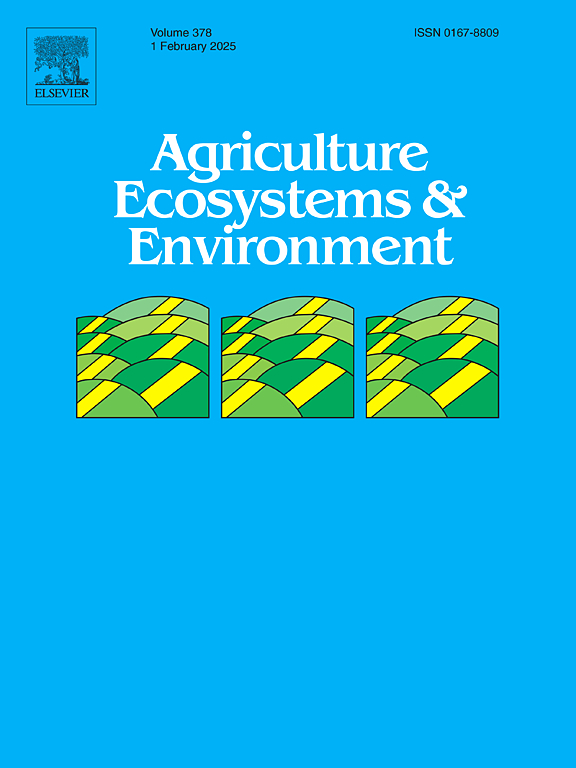Optimizing fungicide deployment in a connected crop landscape while balancing epidemic control and environmental sustainability
IF 6
1区 农林科学
Q1 AGRICULTURE, MULTIDISCIPLINARY
引用次数: 0
Abstract
Bioaggressors cause significant losses in crop production and the efficacy of control methods, primarily based on chemical compounds, comes with considerable environmental and health costs. Plant protection practices implemented locally overlook the mobility of bioaggressors, which can spread between fields, connecting different crop populations. As a consequence, the yield in a given field depends also on the management of connected fields. In this study, the efficiency of different fungicide deployment strategies across a national-scale agriculture landscape is assessed, balancing the conflicting objectives of maximizing crop production and reducing fungicide use. A climate-driven metapopulation model describing the dynamics of the peach (Prunus persica)-brown rot (caused by Monilinia spp.) pathosystem in continental France is used. Fungicide deployment strategies are based on indices or algorithms, considering network topology, epidemic risk, territory, and stochastic sampling, which prioritize sites to be treated first. Finally, the objective of maximizing crop revenue is investigated, assuming that untreated fruit can be marketed at higher prices. The optimal strategy depends on the treatment allocation threshold: if up 20 % of the area is treated, epidemic risk provides the most effective prioritization. If more than 40 % of the area can be treated, a combination of random sampling and risk-based prioritization proves optimal. When only considering monetary revenues, we find that the higher the consumer’s willingness to pay for untreated fruit, the larger the proportion of untreated sites becomes. Fungicide use could be avoided if untreated fruit were sold at 2.9 times the price of treated fruit.
优化杀菌剂在关联作物景观中的部署,同时平衡流行病控制和环境可持续性
生物侵蚀剂对作物生产造成重大损失,而主要以化合物为基础的防治方法的效果会带来相当大的环境和健康成本。当地实施的植物保护措施忽视了生物侵略者的流动性,它们可以在田地之间传播,连接不同的作物种群。因此,某一特定领域的产量也取决于对相关领域的管理。在本研究中,评估了在全国范围内不同杀菌剂部署策略的效率,以平衡最大化作物产量和减少杀菌剂使用的冲突目标。一个气候驱动的元种群模型描述了桃树(Prunus persica)-褐腐病(由念珠菌属引起)在法国大陆的病理系统的动态。杀菌剂的部署策略基于指数或算法,考虑网络拓扑结构、流行风险、地域和随机抽样,优先考虑优先处理的地点。最后,研究作物收益最大化的目标,假设未经处理的水果可以以更高的价格销售。最优策略取决于治疗分配阈值:如果治疗面积达到20% %,则流行病风险提供了最有效的优先级。如果可以处理的面积超过40% %,则随机抽样和基于风险的优先级组合被证明是最佳的。当只考虑货币收入时,我们发现消费者对未经处理的水果的支付意愿越高,未经处理的场地比例越大。如果未经处理的水果售价是处理过的水果的2.9倍,则可以避免使用杀菌剂。
本文章由计算机程序翻译,如有差异,请以英文原文为准。
求助全文
约1分钟内获得全文
求助全文
来源期刊

Agriculture, Ecosystems & Environment
环境科学-环境科学
CiteScore
11.70
自引率
9.10%
发文量
392
审稿时长
26 days
期刊介绍:
Agriculture, Ecosystems and Environment publishes scientific articles dealing with the interface between agroecosystems and the natural environment, specifically how agriculture influences the environment and how changes in that environment impact agroecosystems. Preference is given to papers from experimental and observational research at the field, system or landscape level, from studies that enhance our understanding of processes using data-based biophysical modelling, and papers that bridge scientific disciplines and integrate knowledge. All papers should be placed in an international or wide comparative context.
 求助内容:
求助内容: 应助结果提醒方式:
应助结果提醒方式:


